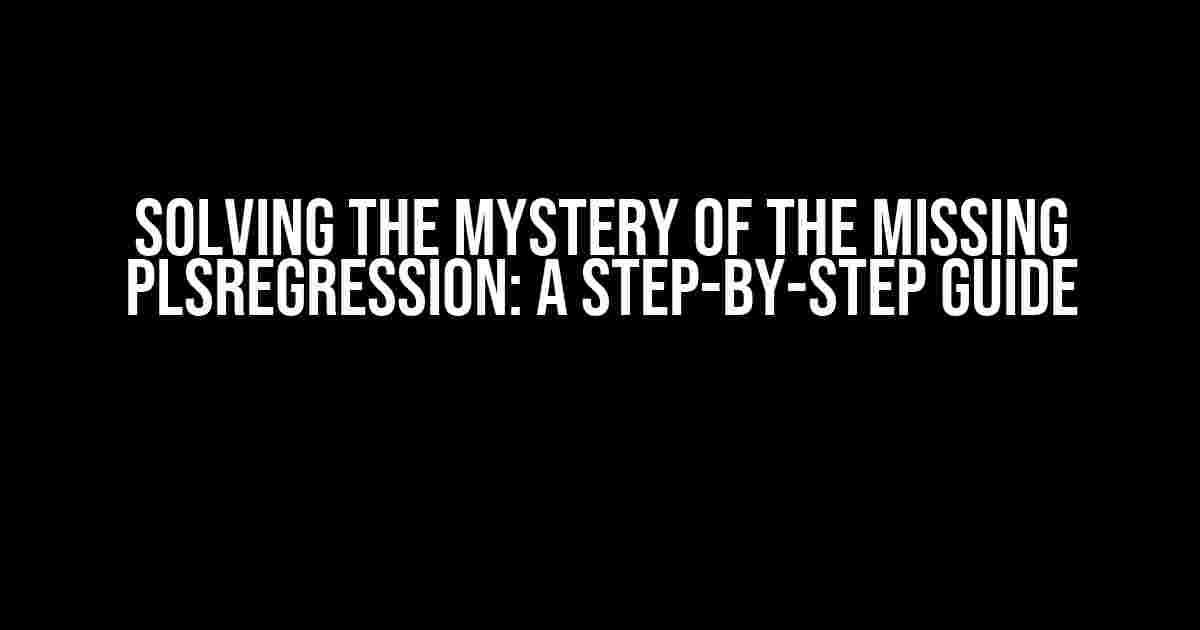Are you tired of scratching your head, wondering why you can’t import PLSRegression with the code “from sklearn.cross_decomposition import PLSRegression”? You’re not alone! In this comprehensive guide, we’ll take you on a journey to resolve this frustrating issue and get you back to building amazing machine learning models in no time.
- What is PLSRegression?
- Step 1: Check Your scikit-learn Version
- Step 2: Ensure Correct Import Statement
- Step 3: Reinstall scikit-learn (if necessary)
- Step 4: Check for Conflicting Libraries
- Step 5: Verify Python and Environment Configuration
- Common Issues and Solutions
- Conclusion
- Bonus: Getting Started with PLSRegression
- Final Thoughts
What is PLSRegression?
Before we dive into the solution, let’s take a quick peek at what PLSRegression is. PLSRegression, short for Partial Least Squares Regression, is a popular algorithm in machine learning used for dimensionality reduction, feature extraction, and supervised learning tasks. It’s a powerful tool in the scikit-learn library, a widely-used Python package for machine learning.
The Problem: “from sklearn.cross_decomposition import PLSRegression” Fails
The issue at hand is that the code “from sklearn.cross_decomposition import PLSRegression” doesn’t work as expected. You’ve tried it, and instead of getting the PLSRegression class, you’re faced with an error message. Frustrating, right? The good news is that we’re about to fix this issue once and for all.
Step 1: Check Your scikit-learn Version
The first step in resolving the issue is to verify that you’re using a compatible version of scikit-learn. PLSRegression was introduced in scikit-learn version 0.17, so if you’re using an earlier version, you won’t have access to this algorithm.
import sklearn print(sklearn.__version__)
pip install --upgrade scikit-learn
Step 2: Ensure Correct Import Statement
from sklearn.cross_decomposition import PLSRegression
Not:
from sklearn.decomposition import PLSRegression
(PLSRegression is part of cross_decomposition, not decomposition.)
Step 3: Reinstall scikit-learn (if necessary)
If you’ve tried the above steps and still can’t import PLSRegression, it’s possible that your scikit-learn installation is corrupted. Don’t worry; we can fix this! Try uninstalling and reinstalling scikit-learn:
pip uninstall scikit-learn pip install scikit-learn
Step 4: Check for Conflicting Libraries
In some cases, conflicting libraries might be causing the issue. If you’re using other machine learning libraries like statsmodels or pyglmnet, try uninstalling them and then reinstalling scikit-learn:
pip uninstall statsmodels pyglmnet pip install scikit-learn
Step 5: Verify Python and Environment Configuration
Ensure that your Python environment is properly configured. Check that:
- Python is installed correctly.
- Your Python version is compatible with scikit-learn.
- You’re using the correct Python environment (e.g., not a virtual environment).
Common Issues and Solutions
We’ve all been there – stuck on a problem that seems impossible to solve. Here are some common issues and their solutions:
| Issue | Solution |
|---|---|
| Error: “ImportError: cannot import name ‘PLSRegression'” | Check that you’re using the correct import statement and scikit-learn version. |
| Error: “ModuleNotFoundError: No module named ‘sklearn'” | Reinstall scikit-learn and ensure it’s installed correctly. |
| Error: “AttributeError: ‘module’ object has no attribute ‘PLSRegression'” | Verify that you’re using the correct import statement and scikit-learn version. |
Conclusion
You made it! By following these steps, you should now be able to successfully import PLSRegression using the code “from sklearn.cross_decomposition import PLSRegression”. Remember to stay calm, patient, and persistent when troubleshooting – it’s all part of the machine learning journey.
Bonus: Getting Started with PLSRegression
Congrats on resolving the issue! Now, let’s get started with PLSRegression. Here’s a simple example to get you started:
from sklearn.cross_decomposition import PLSRegression from sklearn.datasets import load_boston from sklearn.model_selection import train_test_split # Load Boston housing dataset boston = load_boston() X = boston.data y = boston.target # Split dataset into training and testing sets X_train, X_test, y_train, y_test = train_test_split(X, y, test_size=0.2, random_state=0) # Create PLSRegression object pls = PLSRegression(n_components=2) # Fit and transform data pls.fit(X_train, y_train) X_train_pls = pls.transform(X_train) X_test_pls = pls.transform(X_test) # Print transformed data print(X_train_pls.shape) print(X_test_pls.shape)
This code snippet loads the Boston housing dataset, splits it into training and testing sets, creates a PLSRegression object, fits and transforms the data, and prints the transformed data shape.
Final Thoughts
In this comprehensive guide, we’ve taken you through the troubleshooting process to resolve the issue of not being able to import PLSRegression. Remember, machine learning is a journey, and sometimes, it’s the small obstacles that give us the most valuable lessons. Stay curious, keep learning, and happy modeling!
Frequently Asked Question
Are you stuck with the issue of not being able to import PLSRegression using the code “from sklearn.cross_decomposition import PLSRegression”? Don’t worry, we’ve got you covered! Check out these FAQs to resolve your issue.
Q1: What is the correct way to import PLSRegression?
The correct way to import PLSRegression is by using the code “from sklearn.cross_decomposition import PLSRegression”. Make sure you have scikit-learn installed in your Python environment.
Q2: Why am I getting a ModuleNotFoundError when trying to import PLSRegression?
This error occurs when scikit-learn is not installed in your Python environment. You can resolve this by installing scikit-learn using pip: “pip install scikit-learn” or by conda: “conda install scikit-learn”.
Q3: Is PLSRegression available in all versions of scikit-learn?
No, PLSRegression was added in scikit-learn version 0.13. You need to ensure that you have at least version 0.13 installed to use PLSRegression.
Q4: Can I use PLSRegression for classification problems?
No, PLSRegression is used for regression tasks, not classification tasks. It’s a dimensionality reduction technique that projects both the input and output variables to a new space.
Q5: What are some common applications of PLSRegression?
PLSRegression is commonly used in chemometrics, bioinformatics, and social science research. It’s particularly useful when dealing with high-dimensional data and noisy variables.
